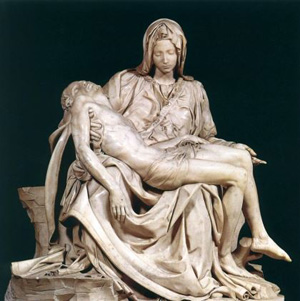
Michelangelo's Pietà , 1499, St Peter's Basilica Rome
This morning I was pondering the many important elements required to make a successful artist. It’s exhilarating – or completely daunting – depending on whether you are in a “glass is half full” or “empty” frame of mind. One thing for sure, if you can achieve a measure of creative and financial success as an artist you can truly say that you have mastered something great in your lifetime – really!
Having said that though, have you thought recently about the level of mastery required to be successful in other professions? Any Olympic medalist has probably been completely married to their sport for decades. They’ve been up every morning at 4am heading off to the pool or the track for 3 hours training before the rest of their day started and on most days they do that for several hours before sleep as well.
A very successful business-person may be no different. They’ve spent many years and $$ at business school then very likely worked 12-15 hour days for years before tasting the champagne of their success. And they did that without any guarantee of success at all. They most probably did it because they loved it.
What’s my point here? I often hear artists commenting about how hard it is to be successful. While I know that it is true, a part of me is always thinking, “Yeah, but if you approached your art career as an Olympic athlete in training, have you really done everything as well as you possibly could? Have you been up at 4am every day painting? Have you marketed your work for 2 hours every day? Have you studied the work of masters every day? Have you really gone for the gold medal?”
Have you? Have you really gone for the gold EVERY DAY?
Well – the truth is that you can’t do it every day – no one can. Everyone needs rest periods and vacations. Heck – I spent most of my life in Australia and we Aussies know more about the importance of rest than anyone:)
But you can do it most days – and that is what you need to do to be very successful.
With that in mind, I brainstormed with myself and came up with 18 tips to make success as an artist an absolute certainty. I’m not saying they’re all possible for you in your life – but if you were able to achieve 50% of each one or 9 out 18, you would be way, way ahead with a successful artistic lifetime. I had fun with these – so please let me know your comments…
- Choose a family that nurtures or challenges your artistic spirit and talent. This is an interesting point that encompases your spiritual viewpoint on life. Some people believe that we choose our parents. Others believe that our parents choose us. Others, still think its a completely random statistical thing.
- Read great literature every day. The works of literary masters can unlock the creative potential in your being in a way that nothing else can. This is one of the keys to opening up the gates of your inner creativity so that you can find your truly authentic artistic voice.
- Listen to classical music while you work – especially Mozart. Classical music will help you to open the creative centers of your being in a way that other music styles cannot.
- Exercise your body and spend time in nature every week. You are a whole person – spiritual, mental, emotional, and physical. All of you needs to be exercised and integrated for optimum success as an artist. Be a renaissance person.
- Don’t watch television. I know this will get a reaction but it’s very important. OK – you can maybe watch your favorite program for an hour but nothing more than that. And mute the sound when the add breaks come on. Television can break down your connection to your creativity and individuality.
- Don’t spend a lot of time on the internet. I know this is an oxymoron because you have to be online to be reading this! Be aware though that the internet can affect you in much the same way as television and it can also be a huge time-waster.
- Study with masters and become a great artist. A great artist has inspiration, talent, uniqueness of vision, and absolute mastery of their medium. It’s not about pretty – its about originality and a way of seeing life.
- Be honest with yourself. You need to assess if you really have what it takes to be a commercially successful artist. Only you can determine this. If you don’t have the talent and persistence needed you won’t be successful – big dreams alone cannot take you there.
- Make a deal with your spouse or partner or family to give you 5 years to focus 100% on your art.
- Work on your art as hard as Michelangelo did. Right now, go and buy a copy of “The Agony And The Ecstasy”. It is a fantastic read and it will show you what hard work and dedication as an artist means! Paint or sculpt or photograph – do whatever you do for at least 4 hours every day.
- Have a stunning online gallery of your work. This is what everyone in the universe is going to see when they get their first impression of you and your art. If it looks less that 100% great everything you’ve done before this and everything you will do after this are pretty much wasted effort. Do you realize how important this is? Think about that when someone tells you that its not worth spending thousands of dollars on an artist website.
- Attend a major art event every week, speak with at least 10 people, and give each one of them your business card with your website address. Invite them all to YOUR next event.
- Hold an Open Studio every month. Advertise in local publications. Invite local arts professionals Send out email invitations to all your email list – even if they are thousands of miles away. You want to demonstrate that there is “something happening” with your art career. Nothing compares with a physical showing of your work involving real people! A little food and some nice wine together with your art will create an environment for selling your work.
- Every year, buy a copy of the Art In America Gallery Guide and make a list of 600 galleries that appear to show work similar in style to yours. And yes – we know that everyone says the gallery system is dying – but the right galleries can still play a major role in your success.
- Every month, send out 50 letters (yes – we mean snail-mail letters) of introduction with a postcard of a very strong piece of your work and an invitation to visit and review your website.
- Commit to a major gallery or art-center showing of your work twice a year and make it happen no matter what. Plan 6 months in advance for each show and make it perfect – curating, framing, catering, assistance, etc. Invite everyone as for your Open Studios. Get advance press coverage for every show.
- Answer every request for information, every email, every response to your mailouts, every phonecall to your artist studio – as if the sender or caller might be wanting to spend $25 Million on your art.
- Like Buzz Lightyear once said, “Never give up, Never surrender!”
The best things in life come from inspired persistence. Does this article give you an idea of the level of effort and commitment you COULD have to your work? If it took that much effort would you still do it?
Michelangelo did. Van Gogh did. Other great artists did. Thats why we remember them as “great”. Are you a great artist? Do you want to be one? If you do you’ll have to make a “great” commitment to the journey.



The introduction and analogy for the athlete or businessman caught me and made the point, for me, very strongly! Everyone know that athletes need a coach to succeed, someone that pushes them and encourage them and show them the way, keep them in focus and make it easier in the hardest times. I don't think any successful athlete can do it alone. So maybe artists can't do it alone as well? Many advisors are talking about taking a mentor, which I find very important. But mentor is not a coach…. Maybe another way for artists could be a buddy-system or two artists working and helping each other….. Many of the Masters had patrons, which encourage them to make art by paying for it and by making the artist a celebrity… Others were prolific and successful in making art, but not so much in its business…
Thanks Daniel, very good point for thought, and of course, for implementation! I sure hope I would have time to do even half of all these great tips
Cheers
Moshe
Excellent point Moshe. That would be the 19th point! If you look at Michelangelo his career was definitely made (at least in the beginning) by Lorenzo de Medici. Vincent had Theo. A mentor is very important – but preferably one who has some skin in the game with you. A favorite collector or fellow artist as you suggest is a great idea.
If you look at Van Gogh for example he had Theo as financial and moral support and inspiration but he also bounced a lot of inspiration around with other artists in the Salons at various times. I think that a community of artists that supports and challenges each other is a great concept – hopefully without too much jealousy in the mix. We are talking about humans here though so there will always be competitive issues to deal with.
Daniel.
Wow, lots to do!! And for me it is all combined with earning a living (no patron here) raising my kids (no nanny either) and maintaining sanity!! Okay, I am up for the challenge. I do have a question regarding the "commit to two major gallery shows per year". How major? And is this where the gallery hangs your work because they believe in you and take a commission, or does the artist pay for the show? I ask this because I was recently contacted by a respectable gallery that found me online and after meeting with me, offered me a show. However, there were many fees involved, much like renting the space, and they still wanted a 50% commission on sold work (a few of the fees did get deducted from the sale of the work). Is this common? Should I have to pay for a show and give a commission? I have had showings of my work recently without these fees, but they were large group exhibits which only included one of my pieces.
Thanks for a great article! The fire is lit…
Tanya
Tanya,
Thanks for the comment and great question. A better wording for what I meant was probably "commit to two major shows at a gallery or art center per year". The major should be referring to the effort and scale of the show and the emotional commitment from you more so than whether it is a major gallery or not. I also mention "art center" because it's quite legitimate to hire a space for a month and stage your own show too. The point is to get in the habit of showing your work and to make the effort to publicize and bring people to it.
Re your question, there are different models with galleries. The more traditional model is purely commission-based but there are now quite a few that require you to pitch in with other costs as well. It's a marketing expense and may be worthwhile if you are trying to get some initial traction in the gallery-based market. We have a couple of clients who have done vanity gallery shows and they have been pretty happy with the results, but I have also heard some not-so-happy stories from other artists. I would do my homework and ask for some references from other artists who have exhibited with them.
Also be aware that given the changing nature of the art market, you need to watch and see if the gallery-sales model is going to work well for you or not.
I smiled at your "all combined with earning a living (no patron here) raising my kids (no nanny either) and maintaining sanity" comment and totally understand – life these days for most of us is like juggling 25 plates while standing on a chair with one leg 🙂 That said though, one of the reasons that I recommend everyone read Irving Stone's, "The Agony and The Ecstasy" is because when you read it you see that Michelangelo had a complex life to deal with too. He was always having to deal with serious family or papal issues – frequently life-threatening ones at that. And yet he still managed to be the "great" artist. It was an exhausting lifetime and he did it! So, I'm not suggesting that he's the role model to follow but I am saying that if it's important enough you will find a way!
Daniel.
When I wrote that note about the coach and the analogy from the sports world, I was thinking (but didn't really write it) that maybe we need a coach system that will actually pay for the coach, very much the same as in sports. This will give the coach the needed insentive to make the artist successful. A win-win situation…
I know in the Art Licensing area there are coaches out there that help artists put together their direction etc, and there are also other coachs for art marketing, but it might be the least explored way by artists…. Maybe its the culture or maybe its the notion that artist is a one-man/woman-show-and-doesn't-need-help-from-anyone… I wonder….
Cheers
Moshe
Delicious Daniel,
This is really really really good!
I celebrate as I see that I already do more than half! Yippee!
😀
May you all have the time, desire, and space to achieve your highest and best good!
Have a Magnificent Day!
Christine Marsh
http://www.christinemarsh.com
My second thought was, "Van Gogh had Theo." My first thought was "Huh, there are some good ideas here that I will want to review when I'm ready to implement them."
Not all things that should be done can be done when they first come to mind. that's ok as long as one is doing the best one can.
😉
I really like your suggestions but I think you missed mentioning the first requirement. You have to be lined up in attitude. You have to be really excited about making art, really wanting success as an artist, and finally really believe IT WILL COME TO YOU. Then you will be inspired to action and can get busy and work at all the things you so clearly spoke about.
To take action without first being lined up runs the risk of getting discouraged, burning out, seeing only the failures of your efforts rather than the successes.
So true Stan! Please see our other article, "Sell Art With Authenticity" (http://artmarketingsecrets.com/2009/12/sell-art-with-authenticity.html) and you will see we think alike!
Daniel.